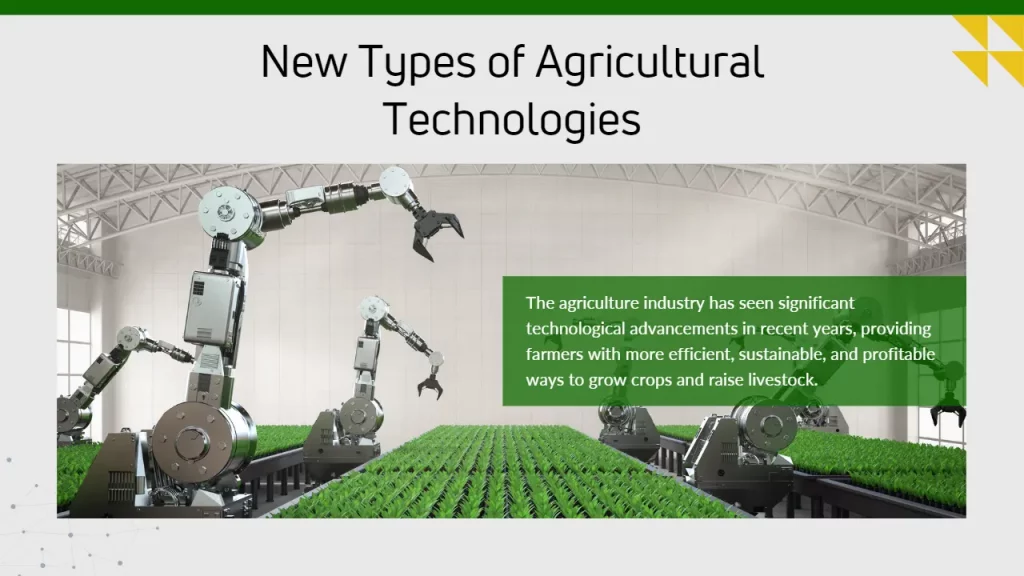The advancement of agricultural technology has been a major topic of discussion as it has implications in terms of food production, economic growth, and environmental protection. New types of agricultural technologies can help farmers maximize their productivity, improve sustainability, and reduce waste.

Many of these new technologies involve the use of cutting-edge methods that have the potential to revolutionize the industry. In this article, we’ll take a look at seven innovative types of agricultural technologies that have the potential to significantly affect the future of the agricultural industry.
Table of Contents
Soil and Water Sensors
Soil and water sensors are a game-changer for the agriculture industry. The sensors are able to measure the amount of moisture and nitrogen in the soil, enabling farmers to determine the optimal time for watering and fertilizing their crops. This can help farmers increase crop yields and reduce the amount of water and fertilizer used.
This technology can also help farmers determine the ideal time to irrigate their fields, reducing water usage and costs. In addition, soil sensors can detect nutrient deficiencies, enabling farmers to apply fertilizers more precisely, reducing waste and cost.
They are inexpensive, robust, and unobtrusive, making them ideal for use in agricultural settings.
Weather Tracking
Agricultural weather tracking is a service that helps farmers protect their crops from weather-related damage. It provides access to an online weather service, as well as a handheld system that can be accessed through mobile apps on smartphones and other mobile devices.
This system can send notifications or signals about hail, frost, and other weather conditions, allowing farmers to take the necessary precautions to prevent crop damage and minimize losses.
Weather tracking technology also enables farmers to adjust their farming practices to mitigate the impact of extreme weather events, improving crop yields and reducing risks.
Satellite Imaging
Satellite Imaging is an advanced technology that allows farmers to monitor their crops more efficiently. By analyzing crop imagery, farmers can save money and time by quickly identifying potential risks and dangers.
This technology can be integrated with water, soil, and crop data to provide farmers with real-time notifications when thresholds are exceeded, allowing them to take action before any damage is done.
By having access to this data, farmers can apply fertilizers and pesticides more accurately, reducing costs and improving crop yields.
Satellite imaging also enables farmers to identify areas that are at risk of erosion or waterlogging, allowing them to take preventative measures to protect their crops.
Pervasive Automation
Pervasive automation refers to the use of robotics and automation in agriculture. This technology can help farmers increase efficiency, reduce labor costs, and improve yields.
Pervasive automation can be used for tasks such as seeding, planting, and harvesting, reducing the need for manual labor. Automation can also improve accuracy, ensuring that crops are planted and harvested at the right time.
RFID Technology
RFID (Radio Frequency Identification) technology is used to track and monitor livestock. RFID tags can be attached to animals, enabling farmers to monitor their location, health, and behavior.
This technology can also be used to track animal feed, ensuring that livestock is receiving the right nutrition. RFID technology can help farmers increase efficiency, reduce costs, and improve animal welfare.
It is also an innovative way to track and monitor agricultural yields. By using water and soil sensors, farmers can easily monitor their crops and link the data to their yields.
This technology is quickly becoming a reality and is allowing farms to market themselves more effectively, as customers can track the yields of their purchases.
Vertical Farming
Vertical farming is an innovative form of urban agriculture that utilizes vertically stacked layers to produce food. It provides many potential benefits, including the ability to set up operations in urban environments, quick access to fresher food, and lower costs.
But this type of farming is not limited to just urban locations; many farmers have used this technique to make the most of their available land, often growing crops that are suitable for the particular climate and conditions of the area.
Minichromosal Technology
Minichromosal technology is being used to modify crops at the genetic level. This technology enables scientists to add or remove specific genes from plant DNA, improving crop yields and making crops more resistant to pests and disease.
Minichromosal technology has the potential to revolutionize the way we grow crops, making them more efficient, sustainable, and profitable.
In conclusion, agriculture technology is advancing at an unprecedented pace, offering farmers a wide range of tools to improve their farming practices. From soil and water sensors to satellite imaging, each technology plays a vital role in modern agriculture, helping farmers to produce more food while reducing costs and environmental impact. As the agriculture industry continues to grow, it is certain that we will see even more groundbreaking technologies in the years to come.



